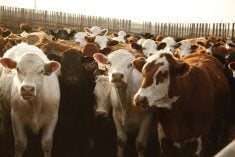Fiona Buchanan believes genes hold important keys to building a calmer cattle herd.
A featured speaker at the Saskatchewan Beef Symposium in Saskatoon Feb. 8-9, the beef cattle molecular geneticist said rank animals, which account for as much as six percent of herds in feedlots, can harm themselves, facilities, handlers and other animals.
“Six percent of 2,000 animals in a feedlot can do a lot of damage,” she noted, citing three test animals that were lost in her study because of a stampede that was started by an agitated animal.
Read Also

Growth plates are instrumental in shaping a horse’s life
Young horse training plans and workloads must match their skeletal development. Failing to plan around growth plates can create lifelong physical problems.
Her research has found a correlation in cattle between genetic variations, growth rates, appetite and stress, said Buchanan, a professor in the University of Saskatchewan’s animal and poultry science department.
“We have evidence this genetic variance increases growth and yield and may also produce calmer animals,” she said.
Buchanan has found that animals containing these two genes have higher carcass and live weights, which could translate into more money in producers’ pockets.
“If you’re a calmer animal, you keep on eating and are not fazed out by what’s happening around you,” she said.
In behavioural studies now under way at the university feedlot, she has noted that some animals kick and thrash about for the minute they’re held on the weight scale. Others are so tame that they spend their time quietly licking at the scale.
“I bet the calm ones are also the heavy ones,” Buchanan said.
Her work is being studied in a commercial setting at Quantum Genetics’s feedlot for its potential genomic application in feedlot management strategies.
The Saskatoon company hopes to create a test to identify these genes in herds through DNA analysis, said Leigh Marquess, Quantum’s chief operating officer.
He said the information could help producers reduce variations in carcass composition and increase feedlot efficiency.














